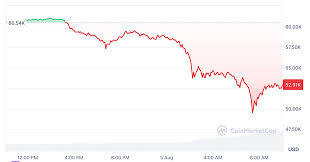Bitcoin (BTC), the flagship cryptocurrency, is well-known for its dramatic price swings. Whether you’re a crypto enthusiast or a cautious observer, it’s natural to ask the big question when its value takes a hit: Why is BTC dropping?
There isn’t always a single reason for such price movements. Instead, a variety of economic, market, and technical factors often converge to influence Bitcoin’s value. Below, we’ll take a closer look at the most common reasons for BTC price drops and the key events you should watch out for to better understand these movements.
1. Market Corrections and Overbought Conditions
One of the most common reasons for BTC price declines is a market correction after an extended rally. Corrections occur when an asset becomes “overbought,” meaning its price has risen too high, too quickly, often fueled by hype or speculation.
For example, Bitcoin recently surged to $92,000 following a major announcement about a strategic crypto reserve by the U.S. government. However, this rapid rise left a price gap on CME Bitcoin Futures, a sharp disparity that was later corrected as BTC dropped to $84,000. These corrections are natural in volatile markets like crypto.
Tip to Watch For:
Keep an eye on technical indicators like the Relative Strength Index (RSI), which shows whether Bitcoin is overbought or oversold. This can help predict a reversal.
2. Macroeconomic Factors
Bitcoin doesn’t operate in a vacuum. Broader economic trends like inflation rates, interest rate hikes, and geopolitical uncertainty can significantly impact crypto markets.
For instance, hawkish policies from central banks, such as the Federal Reserve increasing interest rates, can reduce liquidity in financial markets. Investors often shift from risky assets, such as cryptocurrency, to safer investments like bonds, leading to a drop in BTC’s price.
Example:
If the Fed signals tighter monetary policy, traders often liquidate speculative positions in Bitcoin, causing sharp price dips.
3. Liquidations in Leverage Trading
High-leverage trading is a double-edged sword in the crypto market. Traders often use borrowed funds to amplify their positions, but when prices move against them, exchanges may trigger liquidations by forcefully closing those positions. This creates a cascading effect, pushing Bitcoin prices even lower.
According to recent data, over $900 million worth of bullish futures bets were liquidated when BTC retraced from $92,000 to $83,500. A single event like this can create widespread ripple effects across the market.
What You Can Do:
If you’re trading BTC, avoid over-leveraging your positions to lower your chances of being caught in liquidations. Use stop-loss orders to help protect your investments during sudden market movements.
4. CME Futures Gaps
BTC tends to magnetically fill CME futures price gaps, which are disparities formed when the Chicago Mercantile Exchange (CME) closes for the weekend while global crypto markets continue trading. These gaps often signal potential corrections.
For instance, a notable gap was observed recently between $84,500 and $95,300. Prices retraced to fill the gap, forcing BTC back to $84,000. Historically, such gaps are strong technical signals, as traders believe Bitcoin will eventually return to these levels to regain equilibrium.
How to Spot Gaps:
Monitor CME Bitcoin Futures charts to identify unfilled gaps and anticipate potential price retracements.
5. FUD and Sentiment Shifts
Fear, uncertainty, and doubt (known as FUD) are notorious for shaking up the crypto market. This could stem from a range of issues, such as regulatory crackdowns, exchange hacks, or misleading news stories.
When investors panic, they may sell their BTC holdings, triggering a chain reaction. For example, fear surrounding tighter crypto regulations in certain regions has caused dramatic sell-offs in the past.
Pro Tip:
Stay updated on trusted sources like CoinDesk or CryptoTwitter and avoid making decisions based solely on rumors. Staying informed can help you ride through temporary dips without panic.
6. Geopolitical Developments and Policy Shifts
Bitcoin, as an alternative financial ecosystem, is sensitive to political and policy shifts. Recent developments, such as national-level crypto bans or restrictions on exchanges, can lead to sudden price drops.
Events like regulatory announcements in major crypto markets (e.g., the U.S., China, or the EU) often push traders into a risk-off mode, resulting in temporary price corrections. Even positive triggers, like the recent U.S. administration’s announcement of a crypto reserve, can lead to volatility when coupled with technical factors like overbought conditions.
A Healthy Perspective on Price Drops
Although BTC price drops can be alarming, they’re also part of the natural cycle in a volatile market. Many seasoned investors view dips as opportunities, allowing them to accumulate Bitcoin at lower prices.
If you’re trying to make sense of why BTC is dropping right now, consider both technical signals and larger macroeconomic trends. By staying informed and acting responsibly, you can avoid making emotional decisions that might affect your long-term crypto strategy.
Final Thoughts
Understanding why BTC is dropping requires looking at the interplay between market behavior, technical patterns, and external events like macroeconomic trends or government actions. Whether you’re a trader or long-term investor, staying informed and keeping a clear head during market fluctuations is crucial.
Want to stay on top of Bitcoin price trends and crypto market movements? Learn more through resources like CoinDesk and consider adopting tools that provide real-time market alerts tailored to your trading style.








